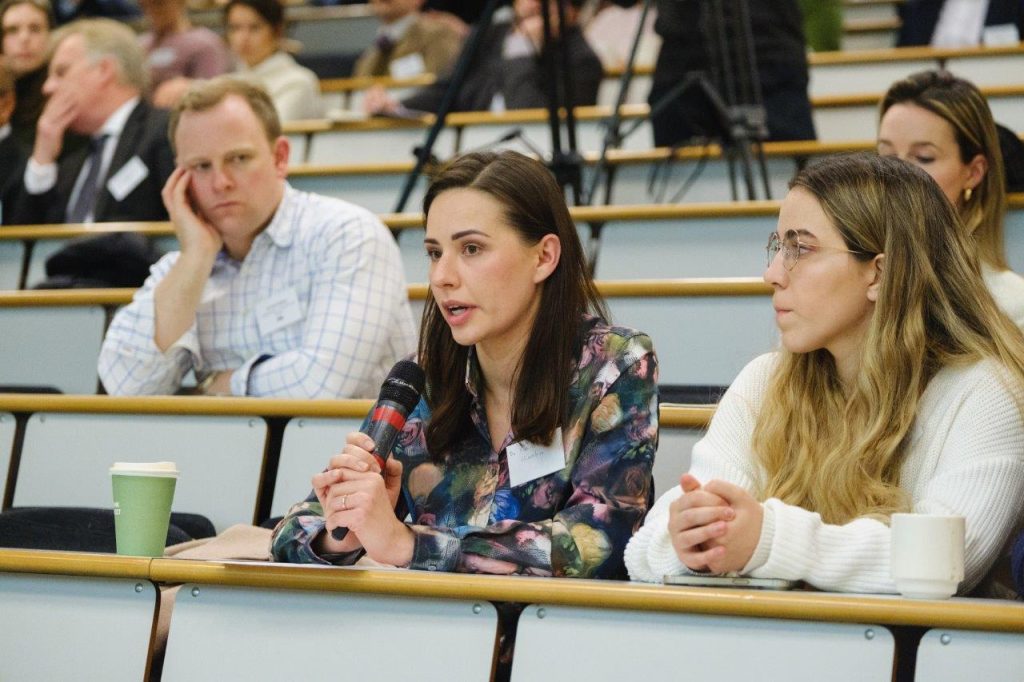Two years on from the invasion of Ukraine, we share a series of blog posts highlighting insights from our Ukraine Health Summit last year, hosted in partnership with the British Red Cross to reflect on and support the delivery and restoration of health services in Ukraine.
The second blog post focuses on the prioritisation of health care reform across the Ukraine health system for recovery and stable peace, and is written by Niki O’Brien, Institute of Global Health Innovation, Imperial College London, with colleagues.

The war in Ukraine has caused substantial disruption to a health system that was already having to manage complex transitions.1
In 2014 the Ministry of Health of Ukraine initiated a national strategy to improve quality and access to care and sought to address longstanding challenges in strengthening primary health care (PHC), among other reforms.2 Since then, a guaranteed benefit package to reduce out-of-pocket payments was set up and enrolment with contracted PHC providers expanded to cover over 70% of the population as of 2020.
Since 2014, initial armed conflicts in the Donetsk and Luhansk regions have had implications on regional health services. However, the ongoing Russian invasion in 2022 has led to widespread disruption and destruction of infrastructure and resources across the country. Nationwide attacks on civilian infrastructure also target healthcare facilities, with over 1,500 damaged or destroyed as of 15 June 2023.3 The occupied territories have been hit particularly hard and face a severe shortage of health care workers (HCWs), medications, and supplies. For example, in the municipality of Melitopol, half of the doctors were forced to leave in the first months of the war.4 National and regional progress towards health policy ambitions has been drastically curtailed as resources have been reallocated to the immediate needs of the emergency response including frontline medical care.
Armed conflicts cause both direct and indirect morbidity and mortality with the latter occurring from both communicable and non-communicable diseases (NCDs). As expected, a rapid increase in infections has been reported, and the destruction of the Kakhovka Dam may further affect many thousands of local inhabitants while increasing the risk of the waterborne diseases.5 Moreover, cancers, oncology, and stroke in particularly can occur as a result of or be exacerbated by stress-mediated pathways.6 In Ukraine, cancer mortality was already high, however, recent research suggests that war-related delay in care of four months for five of the most prevalent cancers could lead to an excess of over 3,600 cancer deaths in the coming years.4
The war has also interrupted reform at the patient, health delivery and policy levels which had been initiated through disease-specific lenses in secondary and tertiary care pre-2022. For example, a significant proportion of Ukraine’s radiotherapy is based on Cobalt-60, rather than modern linear accelerators (LINACs) reflecting a wider need not just to increase basic modern technologies (CT, MR scanners etc) but also to upgrade existing hospital infrastructure.7 Volunteer and humanitarian help are essential but currently fulfil only some of the gaps, challenged further by lack of a nationwide coordination to address the needs of healthcare institutions.

Measures to support Ukraine’s health system both now and in the early recovery period will need to focus on investment in HCWs and working with patient groups. For HCWs, examining and addressing the various push-pull factors, at a policy and systems level are required to support return. Pull factors for return include security and the potential to resume professional advancement and renumeration by re-establishing links between health service delivery and continuing education. Subject to budgetary constraints, the Ministry of Health could consider capitation-based payments and non-financial benefits to encourage relocation to resource-limited geographic areas or specialties.
Research in post-conflict settings highlights the value of indirect financial incentives (e.g., subsidised meals, childcare facilities, support for continuing education) and non-financial incentives (e.g., career development, improved healthcare facility resources and infrastructure).8 Digital learning platforms can further offer HCWs the opportunity to develop their knowledge by undertaking education and training remotely. There is also a need to invest in the PHC workforce (both physician and non-physician) together with substantial investment support and treat patients in the post-war period.
Ukraine is fortunate to have strong physician and patient organizations who can advocate for the needs of patients and communities. Advocating across disease areas and advising on where treatment can be sought, these organizations connect to patients and communities through social media while also working with high-level policymakers to drive change. When ProZorro, an electronic procurement system was launched in 2020 as part of reforms, 100% Life, one of the largest patient organizations in Ukraine used data from the system to fight corruption, with tangible benefits for the Ukrainian health system.9
After one year of war, in 2023 the organisation had collected $968,000 USD for humanitarian aid and provided 4,773,296 packages of medical goods.10 In 2024, the organisation and its partners has continued to support health service delivery by facilitating training and purchasing medical equipment.11 12Importantly, all individuals, organizations, and groups involved in delivering and receiving health care in Ukraine must come together to through a ground-up, community-led approach to realise a people-centred health system and drive people-centred reforms.
To be successful, efforts must be driven by patient, community, and population needs, led by government, and supported by providers and other stakeholders across the public and private sectors. As further atrocities are reported daily as the war in Ukraine rages on, there may be a reluctance to prioritise the planning of future health services. However, health, and therefore health care, is a prerequisite for recovery and stable peace.
References
1. Roborgh S, Coutts AP, Chellew P, Novykov V, Sullivan R. Conflict in Ukraine undermines an already challenged health system. Lancet. 2022 Apr 9;399(10333):1365-1367. Available at: https://www.thelancet.com/journals/lancet/article/PIIS0140-6736(22)00485-8/
2. WHO. Health financing reform in Ukraine: progress and future directions. World Health
Organization, 2022. Geneva, Switzerland. Available at: https://www.who.int/ukraine/publications/i/item/WHO-EURO-2022-5639-45404-64974
3. Міністерство охорони здоров’я України. За понад 15 місяців повномасштабної війни росія пошкодила або зруйнувала 1 554 об’єкти медзакладів. Міністерство охорони здоров’я України, 2023. Kyiv, Ukraine. Available at: https://moz.gov.ua/article/news/za-ponad-15-misjaciv-povnomasshtabnoi-vijni-rosija-poshkodila-abo-zrujnuvala-1-554-ob’ekti-medzakladiv-
4. Khanyk N, Hromovyk B, Levytska O, Agh T, Wettermark B, Kardas P. The impact of the
war on maintenance of long-term therapies in Ukraine. Front Pharmacol. 2022;13:1024046. Available at: https://www.ncbi.nlm.nih.gov/pmc/articles/PMC9731218/
5. Pavlenko D, Pavlenko M, Pavlenko R. Advantages and limitations of teleophthalmology during the war in Ukraine. Graefes Arch Clin Exp Ophthalmol. 2023 Jun;261(6):1761-1763. Available at: https://link.springer.com/article/10.1007/s00417-022-05967-1
6. Jawad M, Hone T, Vamos EP, et al. Estimating indirect mortality impacts of armed conflict in civilian populations: panel regression analyses of 193 countries, 1990–2017. BMC Med, 2020; 18, 266. Available at: https://www.ncbi.nlm.nih.gov/pmc/articles/PMC7487992/
7. Price P, Sullivan R, Zubarev M, Zelinskyi R. Radiotherapy in conflict: lessons from Ukraine. Lancet Oncol. 2022 Jul;23(7):845-847. Available at: https://www.sciencedirect.com/science/article/pii/S1470204522002984?via%3Dihub
8. Witter S, Tulloch O, Martineau T. Health workers’ incentives in post-conflict settings – a review of the literature and framework for research. ReBUILD RPC, 2012. London, United Kingdom. Available at: https://assets.publishing.service.gov.uk/media/57a08a7be5274a31e0000614/rebuild_hwi_lit_review.pdf
9. Hrytsenko, Y. Fight for life: how Ukraine is fixing medical procurement and serving patients better. Open Contracting Partnership, 2021. Available at: https://www.open-contracting.org/2021/02/22/fight-for-life-how-ukraine-is-fixing-medical-procurement-and-serving-patients-better/
10. 100% Life. 100% LIFE, A Year Of Courage. 100% Life, 2023. Available at: https://network.org.ua/en/100-life-a-year-of-courage/
11. 100% Life. With the USAID support, 100% Life covered all primary care physicians in Lviv the training. Available at: https://network.org.ua/en/with-the-usaid-support-100-life-covered-all-primary-care-physicians-in-lviv-the-training/
12. 100% Life. Japanese Ministry of Foreign Affairs funds purchase of equipment for Ukrainian hospitals. Available at: https://network.org.ua/en/japanese-ministry-of-foreign-affairs-funds-purchase-of-equipment-for-ukrainian-hospitals/